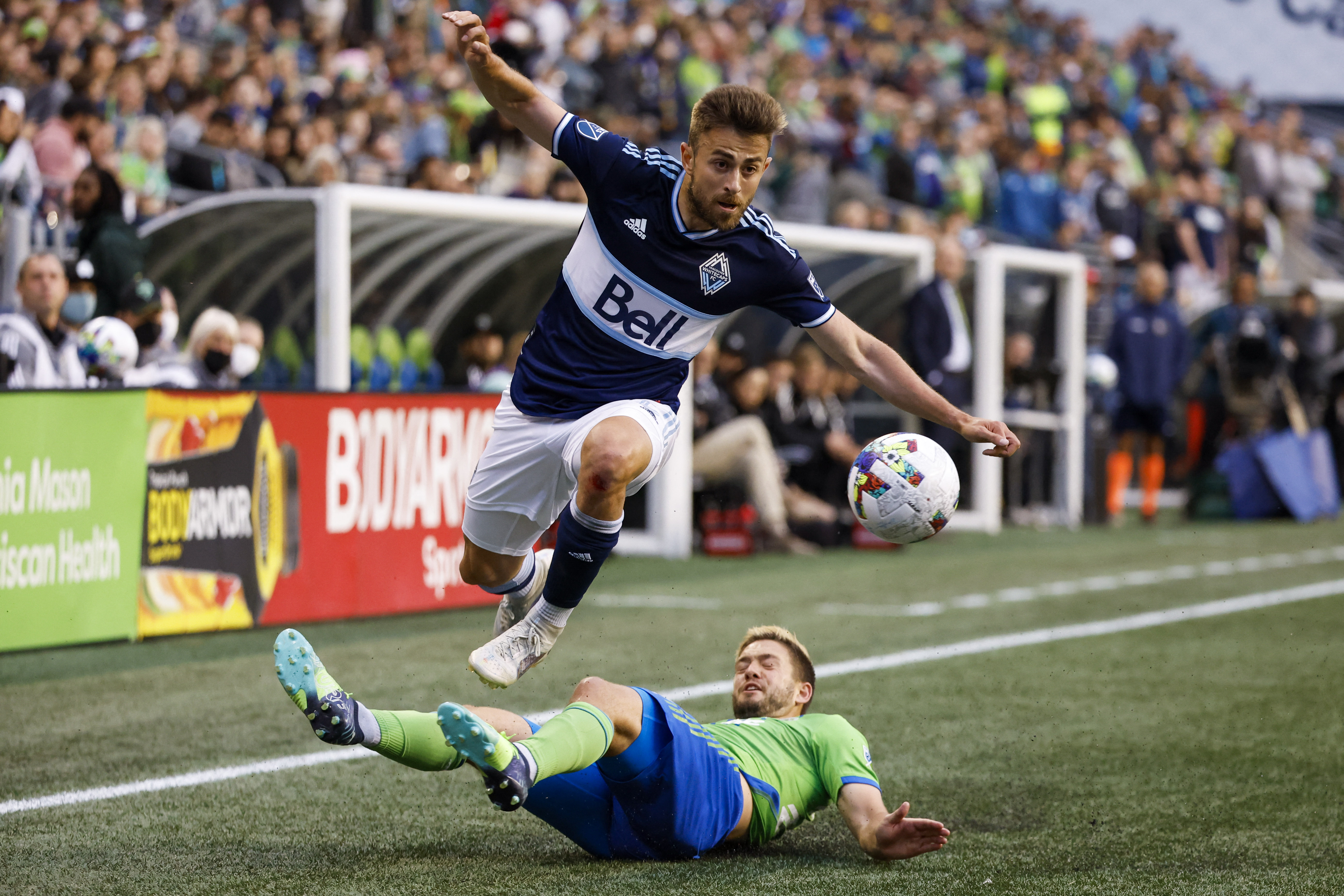You are viewing 1 of your 1 free articles
Paradigm shift: Physiotherapy without surgery may best suit many ACL and meniscus injured patients
There is a paradigm shift taking place in sports medicine. The anterior cruciate ligament has healing capabilities, and conservative management may provide some athletes with optimal functional outcomes. Kieran Richardson undercovers ACL healing and individualized treatment plans to improve long-term outcomes.
Vancouver Whitecaps defender Marcus Godinho evades a slide tackle attempt by Seattle Sounders FC midfielder Kelyn Rowe during the first half at Lumen Field. Mandatory Credit: Joe Nicholson-USA TODAY Sports
The false ACL Narrative
When an athlete sustains an anterior cruciate ligament (ACL) injury, the first thought often points towards early surgical reconstruction and close to a year of rehabilitation. Furthermore, this narrative permeates through sports and general media to members of the public. Therefore, the belief that surgery is the only way to return to sports and a normal life exists in general and in sports medicine folklore. But what if this narrative is inaccurate? What if the best scientific literature uncomfortably challenges or even contradicts this traditional path? Clinicians are obliged to make evidence-informed decisions; however, the recent evidence pool has been met with an uncomfortable resistance as it challenges our pre-existing beliefs.
In 2018, researchers from Finland set out to compare arthroscopic partial meniscectomy (APM), the most commonly performed knee surgery in the world, to placebo surgery with only incisions made in treating patients with degenerative medial meniscus tears. The researchers found no difference between the APM and placebo surgery at the two-year follow-up. Therefore, no evidence supports the idea that patients with mechanical symptoms, certain meniscus tear characteristics, or those who have failed initial conservative treatment are more likely to benefit from APM(1). If APM is not superior to placebo in level one trials, why aren’t we asking similar questions about ACL reconstruction?
Along with the lack of evidence to support surgical intervention, there is also a considerable financial burden(2). Therefore, determining the optimal clinical and cost-effective strategy for managing ACL injuries is essential to improve outcomes. While ACL reconstruction (ACLR) may provide greater tibiofemoral stability in non-weight bearing, it may not be superior to non-surgical management in functional outcomes as neuromuscular rehabilitation can improve knee stability(3). Hence, following ACL rupture, patients may benefit from non-operative interventions before surgical intervention is considered(2).
Multiple risk factors may predict treatment outcomes, such as athlete age, sex, professional and sports activity level, lesions associated with ACL rupture, and time from injury to treatment. Clinicians may believe that ACLR reduces the incidence of meniscus injuries; however, this is questionable(3). One possible reason why this assumption exists is that most athletes do not return to their previous sports level following surgery, reducing their risk of injury and questioning the necessity of the surgery in the first place.
The development of osteoarthritis (OA) following ACL injury is common in athletes, although frequently not associated with pain. However, surgical reconstruction is not superior to conservative management in preventing the development of OA(2,3). Therefore, clinicians should educate athletes that irrespective of their management pathway, their risk of re-injury and OA remains high (around 50%). Rehabilitation is essential to mitigate the risks and restore functional capacity following either pathway.
Is surgery hitting the target?
Until 2013, the KANON study was the only level-one randomized controlled trial with long-term follow-up. The KANON study set out to compare the patient-reported and radiographic outcomes between rehabilitation plus early ACLR and rehabilitation and optional delayed ACLR. The researchers recruited active young adults with an acute ACL tear.
The study showed similar outcomes across crucial domains of patient-reported outcomes, OA rates, meniscal tears, surgical rates, and return to sport(4). Interestingly, 51% of patients assigned to optional delayed ACLR opted for delayed reconstruction, but we know this was related to pre-existing preferences and beliefs for surgery(5). At five years, researchers found no significant group differences in the Knee Injury and Osteoarthritis Outcome Score (KOOS) outcome, including the five subscales: symptoms, pain, ADLs, sports/recreation, and quality of life. Furthermore, researchers found no between-group differences in the number of knees having meniscus surgery(4).
In this first high-quality randomized controlled trial, a strategy of rehabilitation plus early ACLR did not provide better results at five years than initial rehabilitation with the option of delayed ACLR. The authors concluded that the results should encourage clinicians and young active adult individuals to consider rehabilitation as a primary treatment option following an acute ACL tear(4).
Geopolitical influences on treatment selection
Athletes that play sports that involve pivoting, cutting, jumping, and landing have the greatest ACL injury risk. Australia has one of the world’s highest rates of ACL reconstructions, with the most significant growth of surgery occurring in patients under 18 (see figure 1)(6). This increase in surgeries is due to the funding models and pathways that foster government-funded (at least in part) general practitioner consultation, early MRI, early surgical opinion, and early elective surgery. There is evidence of similar medicalized systems in the USA, Canada, France, and New Zealand. However, in Scandinavia, the public pathways promote a physiotherapy-first ethos, with surgery always an option if patients suffer from recurrent instability or lose confidence in their knee, despite attempting high-quality, supervised rehabilitation.
At a recent interprofessional pediatric ACL injury tear management discussion in Perth, Western Australia, discussions revealed that children in the general public without private insurance could receive early ACL surgery. However, these patients cannot access supervised exercise rehabilitation, at times for weeks or even months after surgery due to waiting lists. As rehabilitation is the cornerstone for successful ACLR or non-surgical management outcomes, patients are a high risk for long-term sequelae due to the current medical care pathways.
Figure 1: Significant increase in rates of ACL reconstruction in Australia from 2000-2015(6).

Can the ACL heal without surgery?
Sports medicine clinicians continue to discuss the healing capabilities of a ruptured ACL. Researchers at the Hiroshima University School of Medicine in Japan showed that an acutely injured ACL has healing capability. The researchers suggested that conservative ACL management can produce satisfactory results in individuals and continuous ACL on repeat MRI, provided the patients are willing to accept the slight risk of late ACL reconstruction and meniscal injury(8). Furthermore, the meniscus also showed healing capabilities with non-surgical treatment(7).
ACL-injured patients with repeat high-powered imaging can demonstrate intact, partially healed, or non-anatomically healed, e.g., proximal bundles attached to the PCL(9). Although healing may occur in some patients, others may have persistent tibial translation, increased risk of meniscus tears, and a non-healed ACL.
Rehabilitation protocols with or without bracing show MRI evidence of ACL healing(10,11). For example, researchers at the University of Melbourne in Australia demonstrated that 56% of the KANON participants had a healed ACL at two years and 58% at 5-years following rehabilitation alone. Furthermore, 4% had a healed ACL before undergoing delayed ACLR(11). In addition, an upcoming study from Australia shows data of very high healing rates and restored ligament stability on passive testing of fully ruptured ACLs after a novel bracing protocol.
Figure 2: Initial and follow-up MRI six months after treatment with a non-surgical intervention(10). 
Clinical conclusion
Healthcare policies and business systems to drive medical treatments are frequently rubber-stamped before being proven first in high-quality trials, with knee surgeries a prime example(13,14). Public policy should reflect the best scientific evidence. Reform towards a rehabilitation-first approach, with the option of delayed surgery, if necessary, is desperately needed. Sports medicine clinicians and practitioners must be aware of the lack of evidence to support current cultural trends and the growing evidence that ACL tears can heal.
Clinicians need to inform patients of their options for injury management, both surgical and non-surgical, as well as the percentage of inherent risks, harms, and outcomes, with no need to rush decisions – this reflects how clinicians should be managing athletes across all pain and injury presentations. ACL-injured athletes need time and space to investigate their options for themselves without duress. Physiotherapy needs to be at the center of pioneering this paradigm shift
References
- Ann Rheum Dis. 2018;77(2):188-195
- 2014;21(2):462-470
- Knee Surg Sports Traumatol Arthrosc. 2012;20(1):48-61
- British Journal of Sports Medicine 2013;49:700
- BMC Musculoskelet Disord. 2009 Aug 10;10:100
- Med J Aust. 2018;208(8):354-358
- Clin Orthop Relat Res. 1994;(307):146-154
- Arch Orthop Trauma Surg. 2002;122(4):212-216
- J Orthop Res.2014 Feb;32(2):296-301
- Adv Orthop. 2016;2016:1609067
- J Comput Assist Tomogr. 2017;41(2):206-211
- BMJ Open Sport & Exercise Medicine 2022;8
- 2020;161 Suppl 1:S95-S103
- J Orthop Sports Phys Ther. 2022;52(6):312-344
Newsletter Sign Up
Subscriber Testimonials
Dr. Alexandra Fandetti-Robin, Back & Body Chiropractic
Elspeth Cowell MSCh DpodM SRCh HCPC reg
William Hunter, Nuffield Health
Newsletter Sign Up
Coaches Testimonials
Dr. Alexandra Fandetti-Robin, Back & Body Chiropractic
Elspeth Cowell MSCh DpodM SRCh HCPC reg
William Hunter, Nuffield Health
Be at the leading edge of sports injury management
Our international team of qualified experts (see above) spend hours poring over scores of technical journals and medical papers that even the most interested professionals don't have time to read.
For 17 years, we've helped hard-working physiotherapists and sports professionals like you, overwhelmed by the vast amount of new research, bring science to their treatment. Sports Injury Bulletin is the ideal resource for practitioners too busy to cull through all the monthly journals to find meaningful and applicable studies.
*includes 3 coaching manuals
Get Inspired
All the latest techniques and approaches
Sports Injury Bulletin brings together a worldwide panel of experts – including physiotherapists, doctors, researchers and sports scientists. Together we deliver everything you need to help your clients avoid – or recover as quickly as possible from – injuries.
We strip away the scientific jargon and deliver you easy-to-follow training exercises, nutrition tips, psychological strategies and recovery programmes and exercises in plain English.











